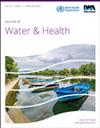Impact of source water quality on total organic carbon and trihalomethane removal efficiency in a water treatment plant: a case study of Upper Awash, Ethiopia
IF 2.5
4区 环境科学与生态学
Q3 ENVIRONMENTAL SCIENCES
引用次数: 0
Abstract
This study addresses the limited understanding of factors affecting the efficiency of water treatment plants in reducing trihalomethane (THM) formation through total organic carbon (TOC) removal, highlighting significant challenges in improving treatment effectiveness. The aim of this study was to examine the influence of water quality on the efficiency of water treatment plants to remove TOC and reduce THM formation. Linear regression and correlation analyses were conducted to examine the relationship between water quality parameters and THM concentrations. The results showed that there was a negative relationship between turbidity, metals, and TOC concentration with TOC removal efficiency. Positive correlations were found between parameters and the formation of THMs in water. Of these parameters, water temperature was observed to have relatively less influence on THM formation. It was observed that seasonal variations in water quality affect the efficiency of TOC removal and THM content in treated water. THM levels in chlorinated water were found to be within the permissible range of the World Health Organization's drinking water quality guidelines. However, it is still important to maintain continuous monitoring and take measures to reduce THMs. The model demonstrated a strong correlation (R2 = 0.906) between predicted and measured THM values.源水水质对水处理厂总有机碳和三卤甲烷去除效率的影响:埃塞俄比亚上阿瓦士案例研究
本研究探讨了影响水处理厂通过去除总有机碳(TOC)减少三卤甲烷(THM)形成的效率的有限因素,突出强调了提高处理效率的重大挑战。本研究旨在探讨水质对水处理厂去除总有机碳和减少三卤甲烷形成的效率的影响。通过线性回归和相关分析来研究水质参数与三卤甲烷浓度之间的关系。结果表明,浊度、金属和 TOC 浓度与 TOC 去除效率之间存在负相关关系。参数与水中三卤甲烷的形成之间呈正相关。在这些参数中,水温对三卤甲烷形成的影响相对较小。据观察,水质的季节性变化会影响 TOC 的去除效率和处理后水中的三卤甲烷含量。研究发现,氯化水中的三卤甲烷含量在世界卫生组织饮用水质量准则的允许范围之内。然而,保持持续监测并采取措施降低三卤甲烷含量仍然非常重要。该模型显示,三卤甲烷的预测值和测量值之间具有很强的相关性(R2 = 0.906)。
本文章由计算机程序翻译,如有差异,请以英文原文为准。
求助全文
约1分钟内获得全文
求助全文
来源期刊

Journal of water and health
环境科学-环境科学
CiteScore
3.60
自引率
8.70%
发文量
110
审稿时长
18-36 weeks
期刊介绍:
Journal of Water and Health is a peer-reviewed journal devoted to the dissemination of information on the health implications and control of waterborne microorganisms and chemical substances in the broadest sense for developing and developed countries worldwide. This is to include microbial toxins, chemical quality and the aesthetic qualities of water.
 求助内容:
求助内容: 应助结果提醒方式:
应助结果提醒方式:


